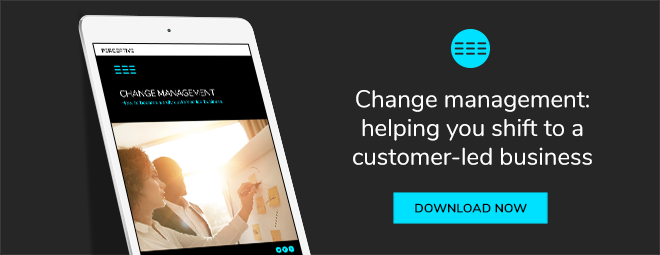When transitioning to become a customer centric business, your business will encounter many challenges. Having a solid change management strategy will prevent many mishaps from becoming bigger issues.
Here are seven things to bear in mind when managing this kind of change.
1. Build awareness and understanding
Your organisation should understand the need for feedback, especially if you haven’t previously invited feedback from your customers.
Consider every staff member that your programme will impact, and highlight that you'll use the feedback to improve continuously. Create a communications plan that includes repetition of messaging, so that the implementation sinks in and gives staff enough time to discuss any concerns they have.
Related content: 5 secrets to a successful employee engagement survey
2. It’s a team effort
Ensure that everyone is involved in some way in the roll out of your customer experience programme. It’s important that everyone feels that his or her opinions count. A common tactic is to set up a cross-functional team to input on the programme, and ask the leadership team to recognise the importance of the team’s efforts.
Gather feedback from your employees, before, during and after the roll out of the programme. This way, you are not only alerted to any potential issues but also are making it clear that it's everyone's responsibility to build better experiences.
Related content: 5 ways to motivate your employees
3. Highlight both good and bad feedback
It‘s important you balance the positive and negative feedback in your customer experience strategy so that your organisation gets an authentic view.
If you highlight negative feedback, there’s a risk you create a sense of defeat and dissatisfaction. On the flip side, if you highlight positive feedback, you may give the impression that everything is fine and that there are no issues to manage and learn from.
Ensure your customers are given opportunities to share their thanks and recognise excellent experiences. Sharing positive feedback with the employees or teams that delivered those experiences means that other employees will notice and this can have a great flow on effect for performance.
Related content: How do you action negative customer feedback?
4. Share your early wins
When you’re first implementing a customer experience change management initiative, it's crucial to get your internal stakeholders on board. If you've done a good job of getting everyone to buy into the solution, you'll increase your chances of success.
Sharing early wins in terms of customer experience success stories, means you’ll gain more understanding of the importance of customer experience and more alignment internally. Also, don’t forget to share great customer stories in your communications like newsletters, videos and emails.
Related content: 5 tricks to leverage your Voice of Customer programme for ROI
5. Make customer feedback a matter of priority—for everyone
If getting feedback is a priority for everyone in the business, your company will gain crucial insights into how well you’re actually performing and what the word-of-mouth is. It’s essential that you get an independent view on your feedback. Using a third party provider to capture the feedback is a popular tactic.
Reviewing customer feedback as an agenda item in leadership meetings is a good way to incorporate this on a high level. Make sure it’s not sugarcoated; it needs to be the good, the bad and the ugly. Give an overarching view but also go into the details such as customer metrics and trends over time.
Related content: The best way to analyse your customer experience feedback
6. Be realistic about internal adoption
When you change business priorities or implement a change of any kind, it's important to expect resistance. This is exactly why you need to manage internal resistance, i.e. change management. If you have people in your organisation resisting the change, try to understand the reasons for why they feel that way.
If you have identified someone who is resisting the enrolment of the customer experience programme, chances are others will feel the same. Once you’ve identified the reasoning behind the resistance, address it straight away. Remember, that disengaged employees will slow you down, so the need to re-engage them is great. In the worst case scenario, you might have to assess the need to keep them all together.
The best way to ensure understanding and adoption is to use training and education to talk about why customer experience is important. Clearly explain what the opportunities are, and what could happen in the case of ignorance. When planning your follow-up initiatives, focus on your resistors, the underlying causes and providing a resolution. If you're approaching it right, you'll find that the adopters will be in the majority.
7. Don’t set KPIs too early
Avoid setting KPIs and improvement targets early on as you want to allow your business to get comfortable with listening and responding to feedback. When you’re in the early stages of implementing a customer experience programme, focus on making customer feedback part of the company-wide thinking and the building-blocks of the way you do business.
Once your employees are using the closed-loop feedback methods, your action plan is to set clear objectives and ensure everyone is accountable for the customer experience.
Related content: Master the metrics that matter—how to measure marketing ROI
Check out our ebook on change management to learn effective strategies to implement change in your business. Get it for free here:

